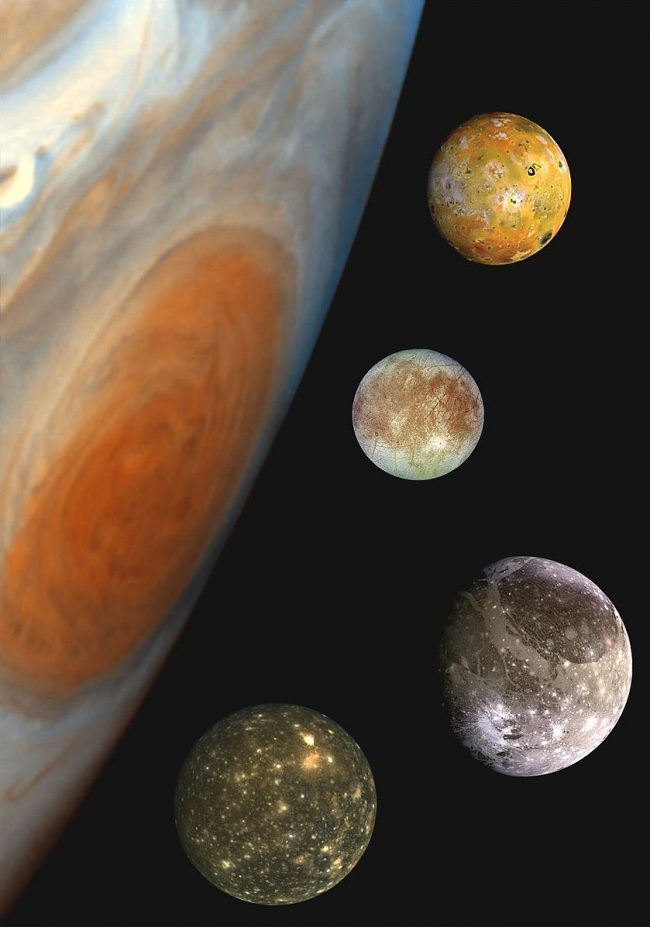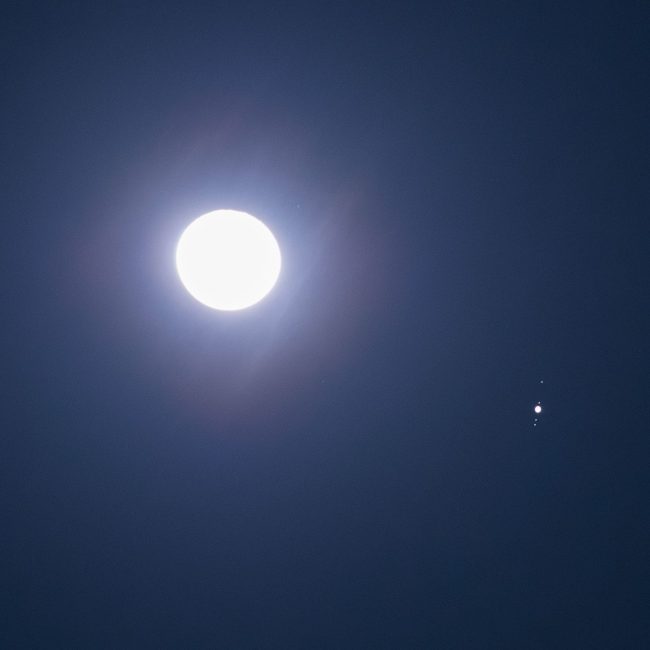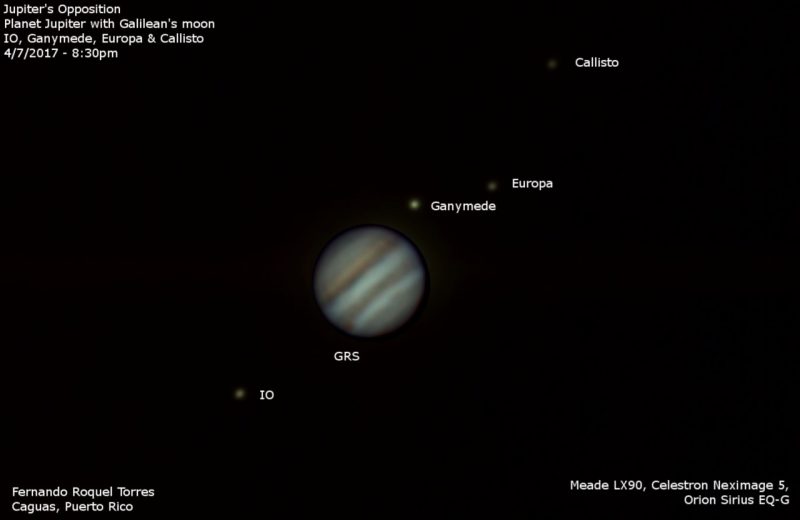

Composite image of Jupiter and its 4 Galilean moons. From top to bottom the moons are Io, Europa, Ganymede, Callisto. The Galileo spacecraft obtained the images to make this composite in 1996. Image via NASA PhotoJournal.
If you have binoculars or a telescope, it’s fairly easy whenever Jupiter is visible to see the giant planet’s four largest moons. They look like pinpricks of light – like tiny “stars” – all on or near the same plane crossing the planet. They’re often called the Galilean moons to honor Galileo, who discovered them in 1610.
In their order from Jupiter, these moons are Io, Europa, Ganymede and Callisto.

Jupiter and 3 of its 4 Galilean satellites, as they’d appear in a small telescope. Illustration via SkyandTelescope.com.
Writing at SkyandTelescope.com this year, Bob King said:
Etched in my brain cells is an image of a sharp, gleaming disk striped with two dark belts and accompanied by four star-like moons through my 2.4-inch refractor in the winter of 1966. A 6-inch reflector will make you privy to nearly all of the planet’s secrets …
When magnified at 150× or higher [the four Galilean moons] lose their star-like appearance and show disks that range in size from 1.0? to 1.7? (current opposition). Europa’s the smallest and Ganymede largest.
Ganymede also casts the largest shadow on the planet’s cloud tops when it transits in front of Jupiter. Shadow transits are visible at least once a week with ‘double transits’ — two moons casting shadows simultaneously — occurring once or twice a month. Ganymede’s shadow looks like a bullet hole, while little Europa’s more resembles a pinprick. Moons also fade away and then reappear over several minutes when they enter and exit Jupiter’s shadow during eclipse. Or a moon may be occulted by the Jovian disk and hover at the planet’s edge like a pearl before fading from sight.
You’ll find a complete list of all eclipses, transits, and occultations for 2019 by downloading Sky & Telescope’s Phenomena of Jupiter’s Moons pdf. You can also gets daily predictions for the moons and a diagram showing their relative positions by consulting the online Jupiter’s Moons Observing Tool.
Read more: We go between the sun and Jupiter this week

View at EarthSky Community Photos. | Beautiful shot of Earth’s moon – plus Jupiter and its 4 largest moons – on May 20, 2019, via Asthadi Setyawan in Malang, East Java, Indonesia. Thank you, Asthadi!
The Galilean moons orbit Jupiter around its equator. We do see their orbits almost exactly edge-on, but, as with so much in astronomy, there’s a cycle for viewing the edge-on-ness of Jupiter’s moons. This particular cycle is six years long. That is, every six years, we view Jupiter’s equator – and the moons orbiting above its equator – most edge-on.
And that’s why, in 2015, we were able to view a number of mutual events (eclipses and shadow transits) involving Jupiter’s moons, through telescopes.
Starting in late 2016, Jupiter’s axis began tilting enough toward the sun and Earth so that the outermost of the four moons, Callisto, had not been passing in front of Jupiter or behind Jupiter, as seen from our vantage point. This will continue for a period of about three years, during which time Callisto is perpetually visible to those with telescopes, alternately swinging above and below Jupiter as seen from Earth.
The next eclipse series of Callisto, whereby this moon actually passes behind Jupiter, starts on November 9, 2019, and ends on August 22, 2022, to present a total of 61 eclipses. After that, the next eclipse series will occur from May 29, 2025 to June 7, 2028, to feature 67 eclipses.
Click here for a Jupiter’s moons almanac, courtesy of SkyandTelescope.com.
Click here for recommended sky almanacs; they can tell you Jupiter’s rising time in your sky.

Fernando Roquel Torres in Caguas, Puerto Rico, captured Jupiter, its Great Red Spot and all 4 of its largest moons – the Galilean satellites – at Jupiter’s 2017 opposition.
Bottom line: How to see Jupiter’s moons.
Source:
https://earthsky.org/astronomy-essentials/how-to-see-jupiters-moons